|
.
The British casualty returns of 89th Regiment of Foot
(preserved in the War Office, signature W.O.25/2105)
have had the three sheets with the casualty listings
for Fuengirola torn out." - George Nafziger, USA
|

Introduction.
Lord Blayney had very low opinion about the Poles
saying that "little dependence could be placed" on them.
 Fuengirola is southwest of Malaga, east of Cadiz, in Spain. To the north of Fuengirola is Sierra Mijas, to the south is Mediterranean Sea. Fuengirola used to be a quaint fishing village. In the 17th century, a new settlement developed, once the threat from Turkish and Moroccan pirates disappeared, and at the beginning of the 18th century, an inn was opened near the beach, offering accommodation to travellers, muleteers and seafarers.
Fuengirola is southwest of Malaga, east of Cadiz, in Spain. To the north of Fuengirola is Sierra Mijas, to the south is Mediterranean Sea. Fuengirola used to be a quaint fishing village. In the 17th century, a new settlement developed, once the threat from Turkish and Moroccan pirates disappeared, and at the beginning of the 18th century, an inn was opened near the beach, offering accommodation to travellers, muleteers and seafarers.
 The British forces at Fuengirola were commanded by Andrew Thomas Blayney, 11th Baron Blayney. He was veteran of Irish, Dutch, Italian, Egyptian and Indian campaign and participant of the siege of Malta. Blayney served during the retreat through Holland (1794-95) "distinguishing himself in every encounter." It was Lord Blayney's resistance to surrender at Boxtel which prevented this retreat from being a rout. In 1796 he was promoted to the rank of Lieutenant-Colonel.
In 1809 Blayney sailed from Gibraltar toward Fuengirola defended by Poles, about whom he had very low opinion saying that "little dependence could be placed" on them.
The British forces at Fuengirola were commanded by Andrew Thomas Blayney, 11th Baron Blayney. He was veteran of Irish, Dutch, Italian, Egyptian and Indian campaign and participant of the siege of Malta. Blayney served during the retreat through Holland (1794-95) "distinguishing himself in every encounter." It was Lord Blayney's resistance to surrender at Boxtel which prevented this retreat from being a rout. In 1796 he was promoted to the rank of Lieutenant-Colonel.
In 1809 Blayney sailed from Gibraltar toward Fuengirola defended by Poles, about whom he had very low opinion saying that "little dependence could be placed" on them.
British Troops
"The infantry is the best portion
of the British army..."
- French General Foy
The British infantry wore shakos, red uniforms, and white or grey trousers.
They were armed with muskets. British battalion had 10 companies.
Lord Blayney had 2,512 British and Spanish troops and number of guerillas:
 - British II Btn./89th Regiment of Foot (353 men). They were nicknamed "Blayney's Bloodhounds." (ext.link) - British II Btn./89th Regiment of Foot (353 men). They were nicknamed "Blayney's Bloodhounds." (ext.link)
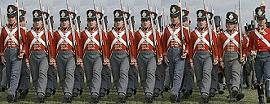
 - British I Btn./82nd Regiment of Foot (932 men) - British I Btn./82nd Regiment of Foot (932 men)
 - foreign battalion (509 men) - foreign battalion (509 men)
 - 5 guns (incl. one giant 32pdr) served by 69 British gunners - 5 guns (incl. one giant 32pdr) served by 69 British gunners
 - British naval crews and gunners of frigates and 5 gunboats - British naval crews and gunners of frigates and 5 gunboats
 - British battleship "Rodney" with 74 cannons - British battleship "Rodney" with 74 cannons
 - Spanish Regiment de Toledo (650 men) - Spanish Regiment de Toledo (650 men)
 - large group of guerillas - large group of guerillas
Polish Troops
" ... their faces blackened by smoke and gunpowder,
and their bloody and torn cloathes,
giving to their whole appearance
a degree of indescribable ferocity."
- Lord Blayney
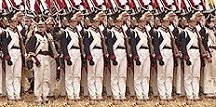 In 1809 Marshal Davout reviewed the Polsih infantry in Warsaw and selected three of the best regiments (4th, 7th and 9th). These troops were sent to Spain where already was the Vistula Legion.
In 1809 Marshal Davout reviewed the Polsih infantry in Warsaw and selected three of the best regiments (4th, 7th and 9th). These troops were sent to Spain where already was the Vistula Legion.
Approx. 150 (165 ?) Poles garrissoned an old castle in Fuengirola that remembered the times of wars against the Arabs. Napier writes: "garrison, which did not exceed 200 men".
This tiny garrison was commanded by Captain Franciszek Mlokosiewicz (born in May 1769, wounded in 1813 at Leipzig).
 - single company of Polish 4th Infantry Regiment. Picture of 4th Infantry in 1810-1812
->> (ext.link) - single company of Polish 4th Infantry Regiment. Picture of 4th Infantry in 1810-1812
->> (ext.link)
 - 4 very old guns and ... 3 Spanish gunners (they deserted after first shots) - 4 very old guns and ... 3 Spanish gunners (they deserted after first shots)
 - 11 French dragoons - 11 French dragoons
|
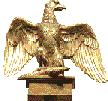
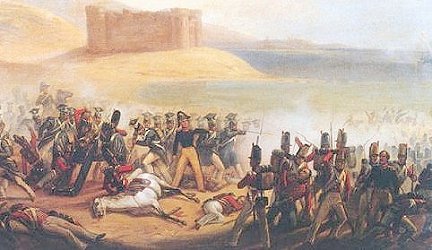 Picture: Polish infantry routing the British redcoats at Fuengirola.
Picture: Polish infantry routing the British redcoats at Fuengirola.

 Fuengirola is southwest of Malaga, east of Cadiz, in Spain. To the north of Fuengirola is Sierra Mijas, to the south is Mediterranean Sea. Fuengirola used to be a quaint fishing village. In the 17th century, a new settlement developed, once the threat from Turkish and Moroccan pirates disappeared, and at the beginning of the 18th century, an inn was opened near the beach, offering accommodation to travellers, muleteers and seafarers.
Fuengirola is southwest of Malaga, east of Cadiz, in Spain. To the north of Fuengirola is Sierra Mijas, to the south is Mediterranean Sea. Fuengirola used to be a quaint fishing village. In the 17th century, a new settlement developed, once the threat from Turkish and Moroccan pirates disappeared, and at the beginning of the 18th century, an inn was opened near the beach, offering accommodation to travellers, muleteers and seafarers.
 The British forces at Fuengirola were commanded by Andrew Thomas Blayney, 11th Baron Blayney. He was veteran of Irish, Dutch, Italian, Egyptian and Indian campaign and participant of the siege of Malta. Blayney served during the retreat through Holland (1794-95) "distinguishing himself in every encounter." It was Lord Blayney's resistance to surrender at Boxtel which prevented this retreat from being a rout. In 1796 he was promoted to the rank of Lieutenant-Colonel.
In 1809 Blayney sailed from Gibraltar toward Fuengirola defended by Poles, about whom he had very low opinion saying that "little dependence could be placed" on them.
The British forces at Fuengirola were commanded by Andrew Thomas Blayney, 11th Baron Blayney. He was veteran of Irish, Dutch, Italian, Egyptian and Indian campaign and participant of the siege of Malta. Blayney served during the retreat through Holland (1794-95) "distinguishing himself in every encounter." It was Lord Blayney's resistance to surrender at Boxtel which prevented this retreat from being a rout. In 1796 he was promoted to the rank of Lieutenant-Colonel.
In 1809 Blayney sailed from Gibraltar toward Fuengirola defended by Poles, about whom he had very low opinion saying that "little dependence could be placed" on them.

 In 1809 Marshal Davout reviewed the Polsih infantry in Warsaw and selected three of the best regiments (4th, 7th and 9th). These troops were sent to Spain where already was the Vistula Legion.
In 1809 Marshal Davout reviewed the Polsih infantry in Warsaw and selected three of the best regiments (4th, 7th and 9th). These troops were sent to Spain where already was the Vistula Legion.
 Blayney's troops landed at noon and marched northeast along the shore toward the old castle. At 1 pm "large group of Spanish guerillas" attacked the Poles, captured their cattle and killed and wounded 2 Polish guard. Approx. 40 Poles grabbed their muskets and ran out after the Spaniards. However when Mlokosiewicz saw British warships he recalled his troop.
Blayney's troops landed at noon and marched northeast along the shore toward the old castle. At 1 pm "large group of Spanish guerillas" attacked the Poles, captured their cattle and killed and wounded 2 Polish guard. Approx. 40 Poles grabbed their muskets and ran out after the Spaniards. However when Mlokosiewicz saw British warships he recalled his troop.
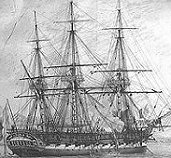 The British frigates and gunboats opened fire. The Poles were forced to serve their old cannons after the Spanish gunners deserted. The Poles sank one gunboat and caused numerous casualties on the remaining 4 gunboats. Soon the British withdrew out of range and only 2 frigates continued fire.
The British frigates and gunboats opened fire. The Poles were forced to serve their old cannons after the Spanish gunners deserted. The Poles sank one gunboat and caused numerous casualties on the remaining 4 gunboats. Soon the British withdrew out of range and only 2 frigates continued fire.
 A British ship-of-the-line "Rodney" arrived with its 74 cannons, carrying the entire I Btn./82nd Regiment of Foot. Lord Blayney ordered the 89th Regiment to leave the hill and march to the beach and draw rations, in the same time he sent boats for the 82nd Regiment. British battery on a hill was left guarded by Spaniards and "foreign battalion".
A British ship-of-the-line "Rodney" arrived with its 74 cannons, carrying the entire I Btn./82nd Regiment of Foot. Lord Blayney ordered the 89th Regiment to leave the hill and march to the beach and draw rations, in the same time he sent boats for the 82nd Regiment. British battery on a hill was left guarded by Spaniards and "foreign battalion".
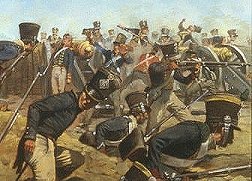 Picture: battle of Fuengirola by Keith Rocco (USA).
In foreground: a Polish officer and infantrymen.
In the background: surrendering British gunners (they wore blue coats) and infantrymen (in red coat). Author gave the Poles french shakos, instead of the traditional top-square chapkas.
Picture: battle of Fuengirola by Keith Rocco (USA).
In foreground: a Polish officer and infantrymen.
In the background: surrendering British gunners (they wore blue coats) and infantrymen (in red coat). Author gave the Poles french shakos, instead of the traditional top-square chapkas.
 The 82nd Foot landed on the beach under the cover of 74 cannons from "Rodney". They formed a "red line" but soon broke ranks and joined the 89th Foot in flight to the boats.
Meanwhile the Poles brought their prisoners, including Blayney, to the castle. Blayney had to step on the castle wall and signal to the ships to cease fire. So he did without any hesitation.
The 82nd Foot landed on the beach under the cover of 74 cannons from "Rodney". They formed a "red line" but soon broke ranks and joined the 89th Foot in flight to the boats.
Meanwhile the Poles brought their prisoners, including Blayney, to the castle. Blayney had to step on the castle wall and signal to the ships to cease fire. So he did without any hesitation.
 General Sebastiani de la Porta commanded all French and Polish forces around Malaga. He arrived to Fuengirola on October 16th and showered the Poles with praise. He also praised them in the report to Marshal Nicolas Jean de Dieu Soult. Mlokosiewicz was awarded with Legion d'Honneur. Blayney's saber is today in Poland, in the city of Krakow. In Warsaw, in the Museum of Army is a picture depicting the heroic defence of Fuengirola.
General Sebastiani de la Porta commanded all French and Polish forces around Malaga. He arrived to Fuengirola on October 16th and showered the Poles with praise. He also praised them in the report to Marshal Nicolas Jean de Dieu Soult. Mlokosiewicz was awarded with Legion d'Honneur. Blayney's saber is today in Poland, in the city of Krakow. In Warsaw, in the Museum of Army is a picture depicting the heroic defence of Fuengirola.
